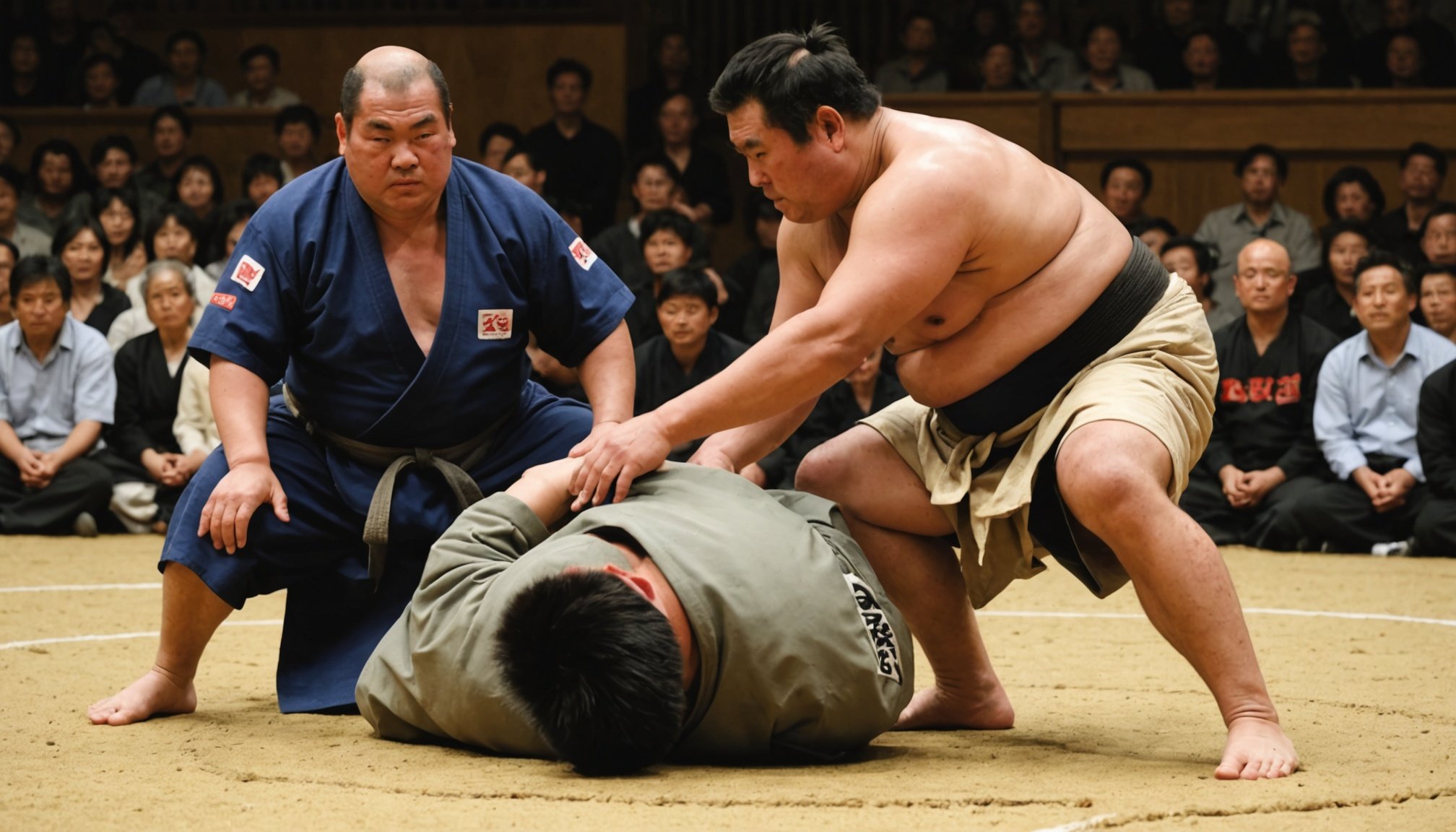Mastering the Tachiai: Strategies for UK Sumo Wrestlers to Elevate Their Initial Charge Technique
Understanding the Tachiai: The Heart of Sumo Wrestling
The tachiai, or the initial charge, is the pivotal moment in a sumo match where the two wrestlers engage for the first time. It sets the tone for the entire bout and can often determine the outcome. For UK sumo wrestlers looking to improve their skills, mastering the tachiai is crucial.
In sumo, the tachiai is more than just a physical collision; it is a mental and strategic engagement. As Kotoshōgiku Kazuhiro, a renowned Japanese sumo wrestler, once said, “The tachiai is where you show your strength and your will to win. It’s not just about power, but also about timing and technique.”[1]
Have you seen this : Ultimate nutrition strategies for effective muscle recovery: essential insights for uk combat sports athletes
Preparing for the Tachiai
To excel in the tachiai, sumo wrestlers must prepare both physically and mentally. Here are some key strategies:
Physical Preparation
- Strength and Conditioning: Sumo wrestlers need to build significant strength, particularly in their legs, core, and upper body. This involves a rigorous training regimen that includes weightlifting, cardio exercises, and specific sumo drills.
- Flexibility and Mobility: Good flexibility and mobility are essential for maintaining balance and generating power during the tachiai. Incorporating stretching exercises and martial arts like aikido or judo can help improve flexibility.
- Diet and Nutrition: A balanced diet rich in protein, carbohydrates, and healthy fats is vital for maintaining the necessary weight and energy levels. Sumo wrestlers often follow a traditional Japanese diet that includes foods like chankonabe, a hearty stew.
Mental Preparation
- Focus and Concentration: Mental toughness is as important as physical strength in sumo. Wrestlers need to focus on their opponents and anticipate their moves. Techniques like meditation and visualization can help improve concentration.
- Strategy and Adaptability: Each opponent presents a unique challenge. Sumo wrestlers must study their opponents’ techniques and adapt their strategy accordingly. For example, if an opponent is known for a strong yori-kiri (force out), the wrestler might focus on defending against this technique.
Techniques for a Successful Tachiai
Here are some specific techniques that can enhance a sumo wrestler’s tachiai:
In parallel : What are some effective cold-weather training techniques for outdoor martial artists?
Grip and Stance
- Yotsu-sumo: This style, favored by Kotoshōgiku Kazuhiro, involves grabbing the opponent’s mawashi (belt) with a right hand outside and left hand inside grip (hidari-yotsu). This grip allows for strong control and leverage[1].
- Stance: A stable stance is crucial for generating power. Sumo wrestlers should keep their feet shoulder-width apart, with their weight evenly distributed between both legs.
Initial Charge Strategies
- Timing: The timing of the tachiai is critical. Wrestlers need to synchronize their charge with the gyoji’s (referee’s) signal to avoid being penalized for a false start[2].
- Power Generation: The initial charge should be powerful but controlled. Wrestlers should use their legs and core to generate force, rather than just their upper body.
Case Study: Kotoshōgiku Kazuhiro’s Approach
Kotoshōgiku Kazuhiro, known for his aggressive and direct fighting style, provides a valuable case study. Here are some key aspects of his approach:
Fighting Style
- Yotsu-sumo Specialist: Kotoshōgiku was a specialist in yotsu-sumo, techniques that involve grabbing the opponent’s mawashi. His most common winning technique was the straightforward yori-kiri (force out), used in sixty percent of his career victories[1].
- Gaburi-yori: His trademark technique was gaburi-yori, which involves using the torso to bump the opponent out, aided by a low center of gravity and momentum.
Mental Approach
- Calming Influence: Despite his aggressive style, Kotoshōgiku emphasized the importance of staying calm. He once said, “I’m getting calmer every passing day. I’ve come through tough times so I’d like to have the mindset to enjoy this.”[1]
- Self-Motivation: Kotoshōgiku’s success was also attributed to his self-motivation. He reflected on the ten-year wait for a Japanese winner and noted that Japanese wrestlers may lack the will to win that Mongolian wrestlers have shown.
Training Tips for UK Sumo Wrestlers
For UK sumo wrestlers looking to improve their tachiai, here are some practical training tips:
Drills and Exercises
- Butsukari-keiko: This is a sumo drill where one wrestler charges at another who is stationary. It helps build strength and timing for the tachiai[3].
- Shiko: Sumo wrestlers practice shiko, which involves lifting the legs high to improve balance and generate power.
Cross-Training
- Judo and Aikido: Incorporating judo and aikido into training can help improve flexibility, balance, and overall martial arts skills. These disciplines emphasize throws, takedowns, and joint locks, which can be beneficial in sumo.
- Conditioning Games: Games like tug-of-war and wrestling drills can enhance strength, endurance, and teamwork.
Cultural and Historical Context
Sumo wrestling has a rich cultural and historical context, particularly in Japan. Here’s how this context can influence UK sumo wrestlers:
Japanese Martial Arts Tradition
- Sumo as a Martial Art: Sumo is deeply rooted in Japanese martial arts tradition. It emphasizes discipline, respect, and self-control. Understanding this cultural context can help wrestlers appreciate the art form and its values.
- Influence of Mongolian Wrestlers: The success of Mongolian wrestlers in sumo has introduced new techniques and strategies. UK wrestlers can learn from these innovations and adapt them to their own style.
International Competitions
- Olympic and World Championships: Participating in international competitions like the Olympic Games and World Sumo Championships can provide valuable experience and exposure to different fighting styles.
- Jungyo Tours: Attending Jungyo tours, which are exhibition matches held outside of the regular tournament schedule, can offer insights into how top wrestlers prepare and perform in a more relaxed setting[3].
Practical Insights and Actionable Advice
Here are some practical insights and actionable advice for UK sumo wrestlers:
Building a Strong Foundation
- Start with Basics: Ensure a strong foundation in sumo techniques, including proper stance, grip, and movement.
- Consistent Training: Regular and consistent training is key. Aim to practice sumo techniques at least 3-4 times a week.
Adapting to Opponents
- Study Opponents: Watch videos and analyze the techniques of your opponents to anticipate their moves.
- Flexibility in Strategy: Be prepared to adjust your strategy based on the opponent’s style and strengths.
Mental Preparation
- Visualization: Use visualization techniques to mentally rehearse the tachiai and other critical moments in the match.
- Positive Self-Talk: Maintain a positive mindset through self-encouragement and focus on your strengths.
Mastering the tachiai is a journey that requires dedication, hard work, and a deep understanding of sumo techniques and culture. For UK sumo wrestlers, incorporating these strategies into their training can significantly elevate their performance.
As Kotoshōgiku Kazuhiro once reflected, “Sumo is about winning. Maybe we Japanese are too set in our ways, maybe we lack the greed to win at all costs… We can learn from them.”[1] This mindset of continuous learning and adaptation is crucial for success in the martial art of sumo.
Detailed Bullet Point List: Key Strategies for Mastering the Tachiai
-
Physical Preparation:
-
Build strength through weightlifting and specific sumo drills.
-
Improve flexibility and mobility through stretching and martial arts training.
-
Follow a balanced diet to maintain necessary weight and energy levels.
-
Mental Preparation:
-
Focus on concentration and mental toughness through techniques like meditation and visualization.
-
Study opponents to anticipate their moves and adapt strategy accordingly.
-
Techniques for Tachiai:
-
Master yotsu-sumo techniques, including hidari-yotsu grip.
-
Practice gaburi-yori and other force-out techniques.
-
Develop a strong stance and timing for the initial charge.
-
Cross-Training:
-
Incorporate judo and aikido to improve overall martial arts skills.
-
Engage in conditioning games like tug-of-war to enhance strength and teamwork.
-
Cultural and Historical Context:
-
Understand the cultural significance of sumo in Japan and its values.
-
Learn from the success of Mongolian wrestlers and adapt their techniques.
-
Practical Insights:
-
Start with the basics and ensure a strong foundation in sumo techniques.
-
Train consistently and adapt strategies based on opponents’ styles.
Comprehensive Table: Comparison of Sumo Techniques
| Technique | Description | Advantages | Disadvantages |
|---|---|---|---|
| Yori-kiri | Force out by grabbing the opponent’s mawashi | Simple and direct, high success rate | Can be predictable |
| Gaburi-yori | Using the torso to bump the opponent out | Effective with low center of gravity and momentum | Requires good balance and timing |
| Oshi-dashi | Push out by thrusting the opponent | Quick and powerful, can catch opponents off guard | Requires strong upper body strength |
| Hidari-yotsu | Right hand outside, left hand inside grip | Strong control and leverage | Can be vulnerable to counterattacks if grip is broken |
By following these strategies, UK sumo wrestlers can significantly improve their tachiai technique and elevate their overall performance in the martial art of sumo.
Understanding the Tachiai Technique
The tachiai technique is fundamental to the rich tradition of sumo wrestling. It’s the initial charge that sets the tone for the bout, making it crucial for wrestlers to perfect this move. The tachiai involves an explosive, head-to-head thrust as wrestlers collide, seeking to gain an advantageous position.
A strong tachiai requires focus on several key elements. First, timing is everything, as the wrestlers must launch themselves at precisely the right moment to catch their opponent off guard. Additionally, balance and posture play a vital role; a stable stance allows for effective absorption or redirection of force. Speed and strength greatly enhance the effectiveness, as they increase the likelihood of unbalancing the opponent.
However, even seasoned wrestlers can make common mistakes during the tachiai. Misjudging the timing can lead to a disastrous fall or losing the initiative. Poor posture might result in a lack of power or vulnerability to counterattacks. Another frequent error is an over-reliance on brute strength rather than a perfect synergy of technique and force.
By understanding and mastering these principles, wrestlers can significantly improve their performance and increase their chances of victory in the ring.
Physical Conditioning for Tachiai
Physical training is paramount for any aspiring sumo wrestler, especially when preparing for a powerful charge during the tachiai. The secret lies in enhancing both strength and agility through a well-rounded approach to conditioning drills.
To build this essential strength and agility, there are several recommended conditioning exercises. Squats, for instance, form the backbone of a sumo wrestler’s routine, helping to develop the necessary lower body power. Additionally, lunges and deadlifts are indispensable for improving balance and explosiveness, two qualities central to an effective charge.
Agility, on the other hand, is honed through exercises such as stepping drills and quick lateral movements. These help sumo wrestlers react swiftly and adjust their positioning during tachiai. A carefully crafted regime incorporating these exercises ensures that both strength and agility are developed harmoniously.
Equally important is the balance between flexibility and explosiveness. Flexibility exercises, such as stretching and yoga, contribute to injury prevention and enhance a wrestler’s ability to maneuver quickly. By integrating these routines with explosive movements like jumps or sprints, wrestlers can maintain a dynamic range of motion while retaining their power.
This balanced approach to strength and agility ensures that sumo wrestlers are optimally conditioned for successful tachiai engagements.
Techniques for Executing a Powerful Tachiai
Achieving a potent tachiai, or initial charge in sumo, requires mastery over several fundamental techniques. Understanding and implementing these methods can enhance a sumo wrestler’s initial advantage in the ring.
Stance and Positioning
A strong stance is crucial when preparing for the tachiai. The wrestler must ensure their feet are adequately spaced, providing a solid foundation. This positioning allows for an explosive start, maintaining stability while utilizing other sumo techniques. Proper stance also sets the stage for absorbing and countering the opponent’s initial movement.
Timing and Accuracy
Timing is pivotal in executing a successful tachiai. Launching the charge too early or too late can compromise its effectiveness. Synchronizing movements with the opponent’s signals enables maximum accuracy and power. Practicing the cadence of this charge is vital, ensuring that the execution aligns with strategic goals.
Use of Hip and Shoulder Power
Harnessing the body’s power centers is essential for a compelling initial charge. The hips and shoulders must coordinate harmoniously, boosting the overall force of the charge. By effectively utilizing hip and shoulder power, wrestlers can exert considerable force while keeping their center of gravity low. This technique not only enhances the impact but also aids in maintaining control after the initial clash.
Psychological Preparation for Wrestlers
In the intense world of wrestling, mental preparation plays a crucial role in athletic performance, particularly during the tachiai, the initial clash. This requires an unwavering competitive mindset. Wrestlers must not only train their bodies but also their minds to execute their strategies effectively.
To start, utilizing focus techniques is key in maintaining concentration. Breathing exercises or meditation can significantly aid in calming nerves before stepping into the ring. Controlled breathing helps regulate emotions, allowing wrestlers to remain composed under pressure.
Moreover, a powerful competitive mindset involves visualizing successful outcomes before the physical match begins. Visualization allows wrestlers to mentally rehearse their movements, building confidence and improving performance. Picturing themselves executing flawless moves during practice enhances muscle memory and precision during the actual match.
Additionally, developing mental resilience helps combat nerves that accompany high-stakes competitions. Staying present and focusing on the task at hand, rather than potential outcomes or past mistakes, is crucial. This mental clarity can often mean the difference between victory and defeat.
Overall, cultivating strong mental attributes alongside physical training provides wrestlers with a comprehensive approach to competition. Wrestlers should embrace these techniques to improve their overall performance and confidently tackle their opponents.
Training Drills to Improve Tachiai
To master the sumo tachiai, a combination of partner drills, solo exercises, and simulation matches can be incredibly beneficial. These practice techniques refine the nuanced movements integral to a successful tachiai.
Partner Drills
Engaging in partner drills is essential for honing your timing and force against resistance. Practising with an opponent allows wrestlers to simulate real match conditions. It enables wrestlers to anticipate rival responses better, adapt tachiai approaches swiftly, and strengthen their overall sparring methods.
Solo Exercises
Solo exercises are particularly valuable for enhancing speed and agility prior to the charge. Techniques like shadow training and agility footwork drills prepare sumo competitors for the quick bursts of energy required in tachiai. These exercises help build muscle memory, ensuring competitors remain poised and quick on their feet during actual matches.
Simulation Matches
Incorporating simulation matches into training regimens helps apply learned skills effectively. These matches create settings that closely mimic competition scenarios, enabling wrestlers to refine their techniques in a controlled, yet realistic environment. This not only helps in discovering personal strengths but also areas where improved sumo training drills are necessary.
By consistently incorporating these sparring methods and practice techniques, wrestlers can significantly enhance their performance at the start of a sumo match.
Analyzing Successful Tachiai Executions
Analyzing successful tachiai techniques is an essential practice for wrestlers striving to refine their skills. By examining video footage and engaging in expert analysis, athletes can identify what differentiates top performers.
One method is the technique breakdown of successful tachiai by renowned wrestlers. This involves analyzing the precise movements, timing, and strategies employed during matches. For example, top wrestlers often exhibit impeccable balance and rapid engagement from the outset, which can be crucial for seizing the advantage.
Learning from expert commentary and detailed case studies can also offer invaluable insights. Analysts often highlight key elements during matches, such as the stance and grip utilized by successful wrestlers. They may point out how certain choices contribute to a competitor’s success, providing a blueprint for others.
In the UK, many wrestlers have adapted unique approaches that reflect both traditional methods and local innovations. Wrestlers there have been noted for their integration of agility and unconventional tactics, which are documented in case studies compiling these unique styles.
Through these case studies, athletes not only learn from international champions but also understand how the sport evolves regionally. By applying these lessons, wrestlers can develop a more comprehensive understanding of effective tachiai executions.
Common Challenges Faced by UK Wrestlers
Entering the world of wrestling in the UK presents unique hurdles that differ from those faced in other regions. Cultural and environmental challenges are prevalent as wrestlers strive to adapt their techniques from traditional styles to those that align more closely with Western practices. The necessity to refine their approach can be pivotal.
Environmental and Cultural Adaptability
One primary challenge is the adaptability in technique. UK wrestlers often need to modify their stances and methods to resonate with a diverse audience and a different competitive landscape. This not only demands physical agility but also mental flexibility to embrace new styles without losing their essence.
Overcoming Size and Experience Obstacles
When it comes to overcoming challenges related to size and experience, wrestlers frequently encounter opponents with varied body types. Building strategies that complement their strengths while mitigating weaknesses is key. Utilising professional guidance and insights from seasoned coaches helps wrestlers refine their technique.
Community and Camaraderie
The importance of community within the wrestling sphere cannot be overstated. Training camaraderie fosters an environment of support, providing emotional and physical encouragement. The shared experiences promote resilience, ensuring wrestlers are well-prepared for both national and global stages. By relying on each other, they build a network that becomes integral to their success.
The Role of Coaching in Mastering Tachiai
Delving into the art of tachiai, coaching strategies prove indispensable for any budding sumo wrestler aiming for mastery. Esteemed coaches, possessing a wealth of experience, emphasize the importance of mentorship in sumo. These seasoned mentors don’t just impart technical skills; they also share their unique insights into perfecting the initial charge.
Through tailored coaching strategies, mentors provide sumo wrestlers with personalized feedback, highlighting areas needing improvement while reinforcing strengths. They design specific drills to hone in on nuances of the tachiai, ensuring that each wrestler progresses in a direction that is most suitable for their style and physique. This customized approach is pivotal in developing proficiency in movements that are vital for a successful tachiai.
Expert opinions from accomplished coaches often stress that mastering tachiai isn’t solely about power. It involves a seamless combination of technique, timing, and mental preparation. Coaches cultivate these attributes by fostering an environment of discipline and encouragement. With consistent mentorship, wrestlers build confidence and develop a deeper understanding of their craft, which, in turn, enhances their initial charge skill.
Ultimately, the insights shared by successful coaches illuminate the path to achieving excellence in sumo, underscoring that expert mentorship is indeed the backbone of mastering tachiai.











